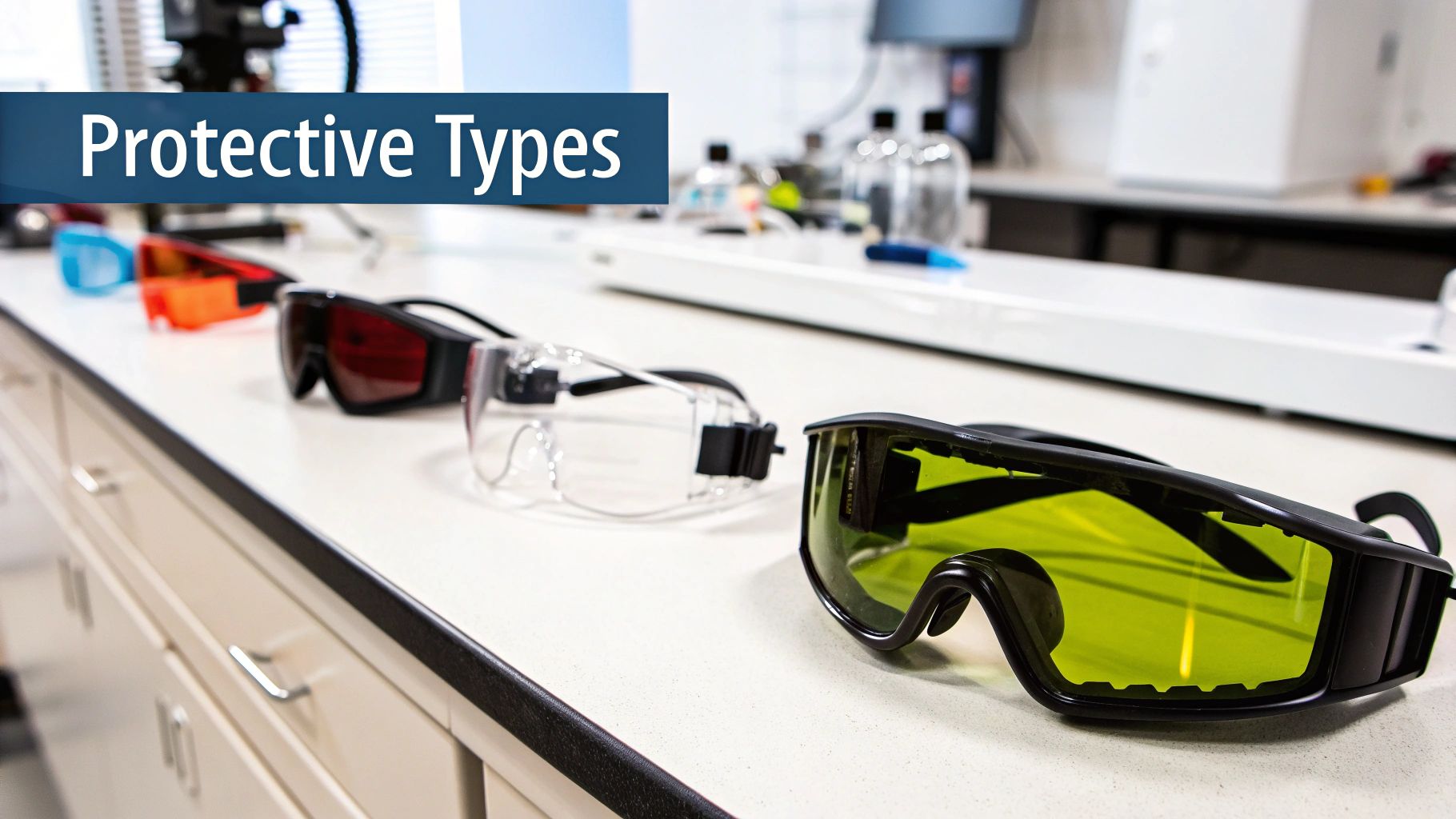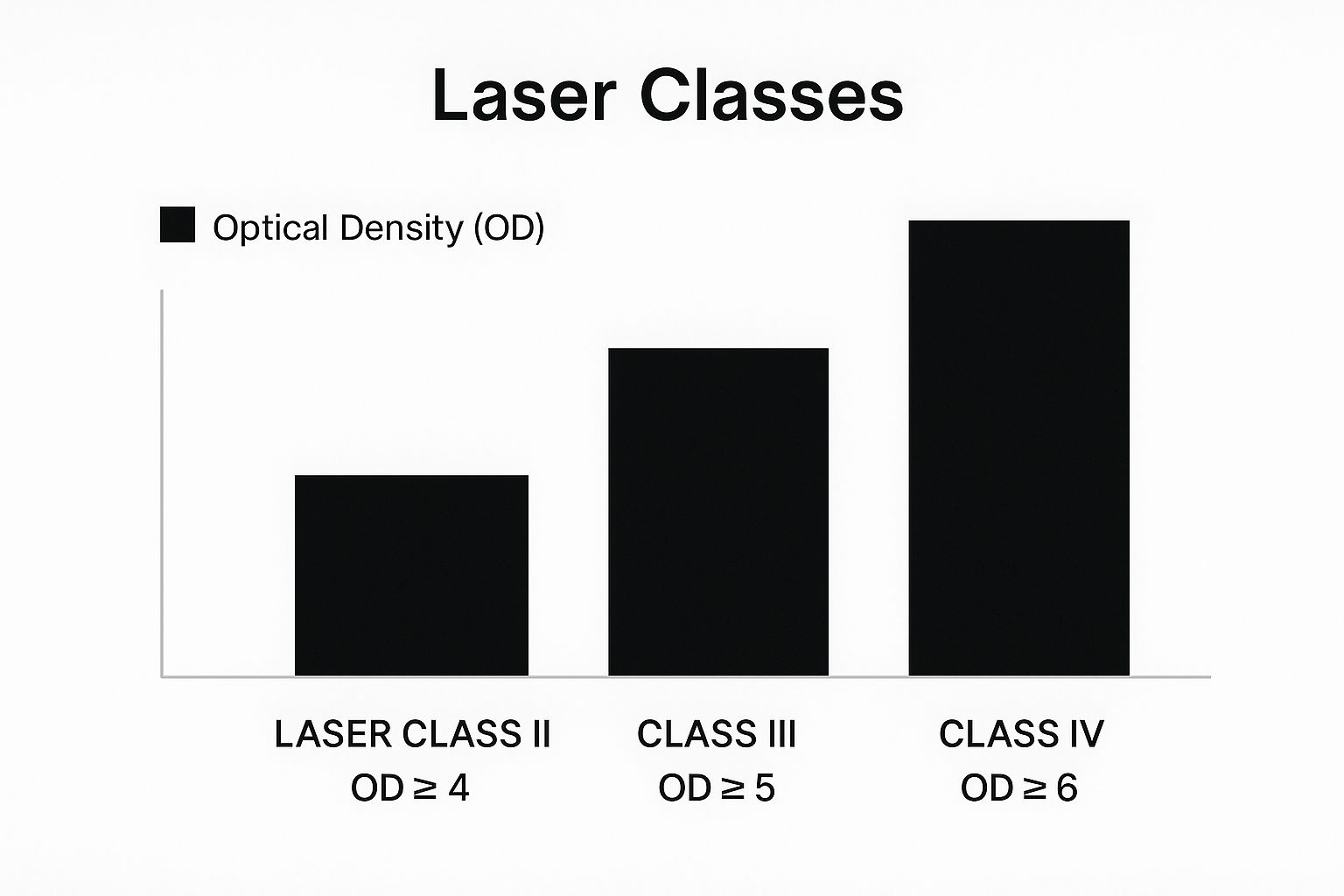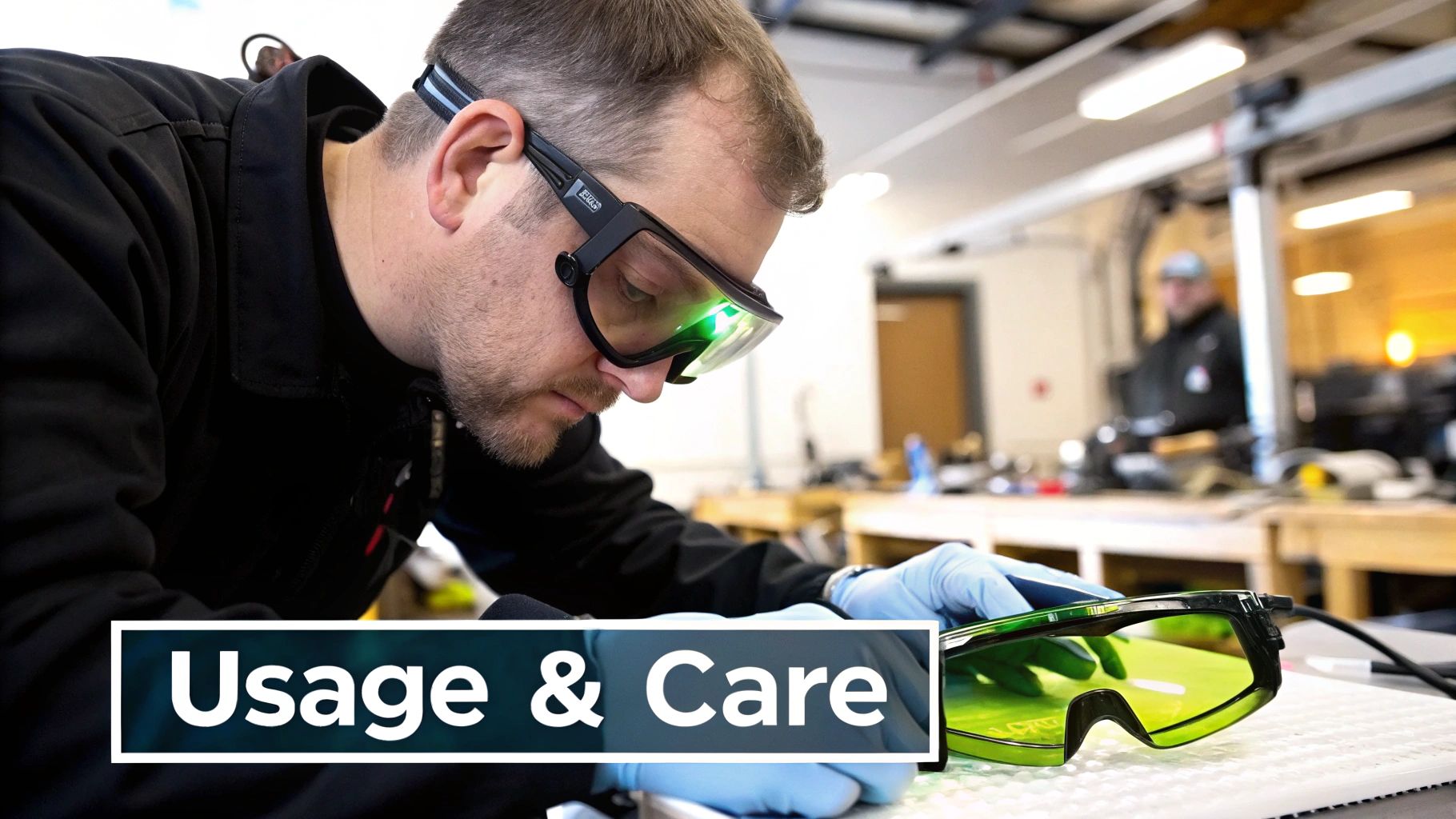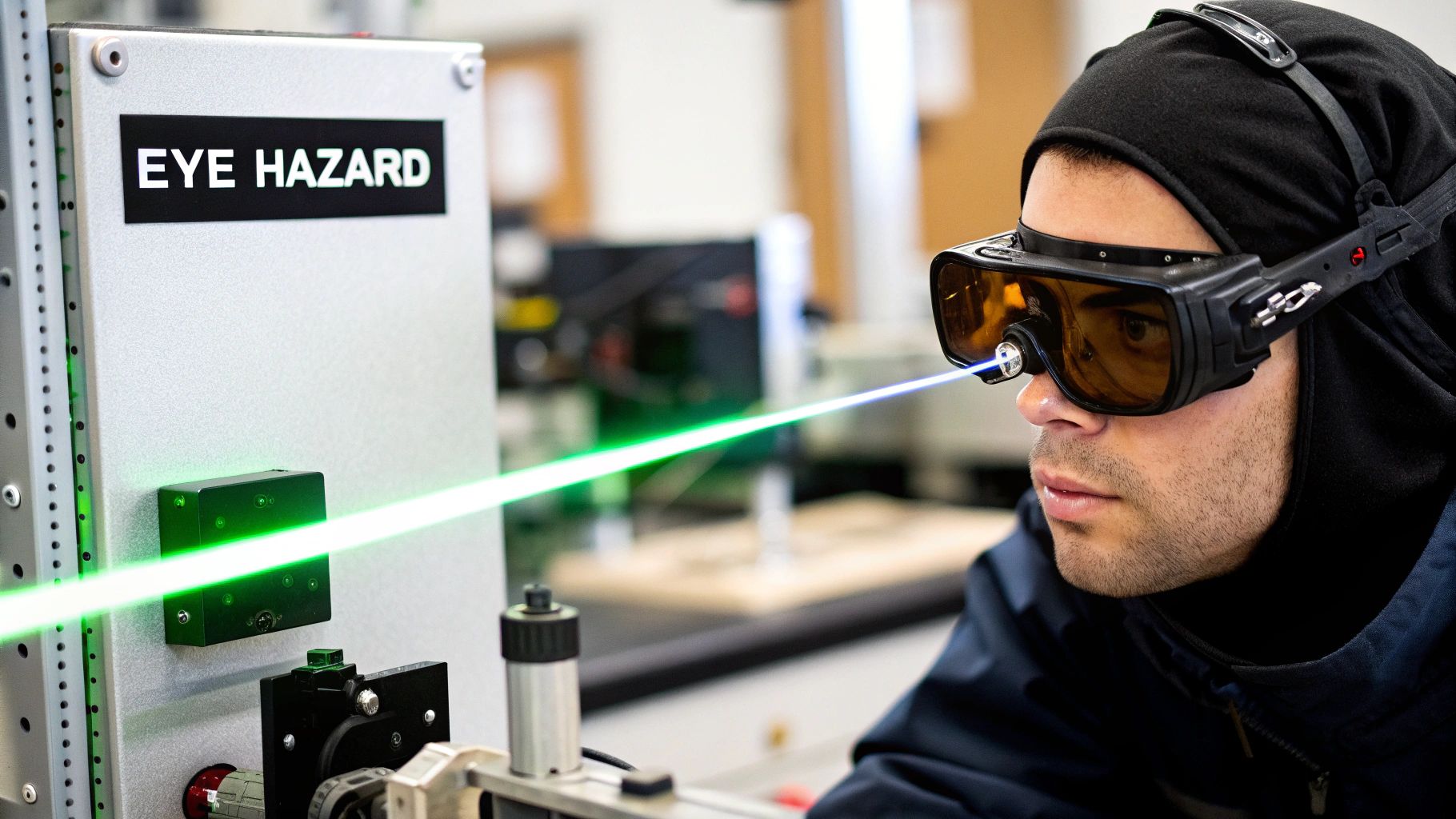Laser Glasses Safety: Essential Eye Protection Tips
- Laserverse

- May 20
- 11 min read
Understanding Laser Eye Hazards in the Real World
Laser eye injuries are a serious concern, and California is not immune. To grasp the extent of this issue, let's explore the science behind these injuries and examine real-world situations where laser exposure presents a risk.
The Devastating Impact of Laser Light on the Eye
The human eye is remarkably sensitive to light. Laser light, due to its concentrated nature, can inflict significant damage. Different wavelengths of laser light affect different parts of the eye. For instance, some wavelengths can cause corneal burns, much like a sunburn on the eye's surface. Others penetrate deeper, causing retinal scarring and potentially permanent vision loss. The eye's ability to repair this kind of damage is limited, making prevention crucial.
Risky Behaviors and Everyday Exposure Scenarios
Many underestimate the dangers of lasers, engaging in risky activities such as aiming lasers at aircraft or other individuals. Surprisingly, there are also everyday circumstances where laser exposure can occur. Construction sites, medical facilities, and even certain entertainment venues utilize lasers, making precautions essential. This means laser safety isn't just for professionals; it's vital for everyone. You might be interested in learning more about laser safety equipment: How to master laser safety with the right equipment.
The use of laser pointers, particularly, has become a significant issue in California, especially in urban areas like Los Angeles. In 2020, 20 incidents were reported involving laser pointers used to blind or distract people, resulting in 24 cases of eye damage. Alarmingly, 20 of those affected were police officers, some of whom were driving at the time. This highlights the importance of laser glasses safety and the need for effective protective measures. More detailed statistics are available: Find more detailed statistics here.
Real-Life Stories and the Importance of Protection
Accounts from individuals who have suffered laser eye injuries underscore the life-altering effects of unprotected exposure. The impact, ranging from temporary vision impairment to permanent blindness, can be devastating. These accounts emphasize the critical need for taking laser safety seriously and consistently using appropriate protective eyewear, such as laser safety glasses. Protecting your eyesight is a crucial investment in your overall well-being. For a broader perspective on safety measures, consider reading about general security practices: Github Security Best Practices.
Navigating California's Laser Safety Regulations Like a Pro

Protecting your eyesight is paramount when working with lasers. California, a hub for diverse industries, maintains strict laser safety regulations. Understanding these regulations isn't just about avoiding penalties; it’s about fostering a safe working environment. This section will guide you through these regulations and help you implement effective safety measures.
Decoding California's Laser Safety Requirements
California's laser safety regulations go beyond the federal OSHA guidelines. These state-specific regulations address unique challenges posed by laser use across various industries. For example, while OSHA offers general guidance, Cal/OSHA (California's Division of Occupational Safety and Health) adds specific requirements for training, equipment, and documentation. This detailed approach highlights California’s commitment to worker safety.
California's Department of Industrial Relations (DIR) mandates appropriate laser safety eyewear for employees exposed to laser beams. These specialized goggles protect against specific laser wavelengths, safeguarding employees from potential eye damage. This regulation is part of a broader effort to enhance workplace safety by emphasizing protective eyewear. While the focus is often on manufacturing and industrial settings, these principles extend to other sectors with laser exposure risks, such as aviation and medical environments. Learn more about these regulations.
Common Violations and How to Avoid Them
A common Cal/OSHA violation is the lack of proper laser safety eyewear. This often arises from misunderstanding the required optical density (OD) and wavelength specifications for different laser classes. Even if eyewear is provided, it may not be the correct type for the laser in use. Inadequate training is another frequent violation. Employees need thorough training on laser hazards and the proper use of safety equipment.
To avoid these violations, invest in high-quality laser safety glasses compliant with the ANSI Z136.1 standard. Ensure the glasses are designed for the specific laser wavelength being used. Implement a comprehensive training program covering fundamental laser safety and industry-specific scenarios.
Practical Implementation and Documentation
Building a laser safety culture goes beyond checklists. Implement practical, easily integrated strategies. For example, create dedicated laser work areas with clear signage and controlled access. Develop pre-use checklists for verifying eyewear condition and suitability.
Finally, maintain comprehensive documentation of training sessions, equipment inspections, and incident reports. This meticulous record-keeping demonstrates compliance and helps identify areas for improvement. These proactive measures not only protect your employees but also enhance workplace efficiency. This comprehensive approach is crucial for achieving long-term safety and operational success.
Selecting Laser Safety Glasses That Actually Work
Choosing effective laser safety glasses is critical for protecting your eyesight. It's not just about marketing; it's about understanding key factors like Optical Density (OD) ratings, wavelength compatibility, and practical considerations like comfort and how well the glasses fit with other equipment. Let's delve into what truly effective laser safety eyewear entails.
Optical Density and Wavelength: The Foundation of Protection
Optical Density (OD) measures how effectively the glasses block laser light. Think of it as an SPF rating for your eyes. Higher OD values mean greater protection. Selecting the correct OD is crucial and depends on the laser's class and its output power. This isn't a one-size-fits-all scenario.

This infographic shows the minimum OD requirements for different laser classes. As laser power increases (from Class II to IV), so does the necessary OD, reflecting the increased risk of eye damage. This highlights the importance of stronger protection for higher-powered lasers.
Wavelength matching is just as important. Lasers emit light at specific wavelengths, and your safety glasses must be designed to block those particular wavelengths. Wearing glasses designed for a different wavelength offers minimal protection. For example, glasses designed for a 650nm red laser won't protect you from a 532nm green laser.
Comfort and Compatibility for Real-World Use
Laser safety glasses are only effective if worn consistently. This means they need to be comfortable, especially for extended periods. In California workplaces, factors like fogging, restricted peripheral vision, and compatibility with prescription glasses become particularly important.
Professionals prioritize features that improve long-term wearability:
Anti-fog coatings: Crucial for clear vision in humid conditions or during strenuous work.
Wide field of view: Allows for better peripheral vision and situational awareness.
Lightweight frames: Reduces fatigue during prolonged use.
Prescription inserts or over-the-glass designs: Accommodate those who need vision correction.
Working with lasers often involves following specific safety rules, similar to obtaining an FAA Part 107 Drone License for drone operation. This emphasizes the need for continuous safety awareness and compliance.
Frame Materials and Lens Coatings: Choosing Durability
In tough environments like industrial settings, the durability of your laser glasses is key. Some frame and lens materials perform significantly better than others under intense conditions.
Polycarbonate lenses: Offer impact resistance and excellent optical clarity, making them the preferred choice for many applications.
Metal frames: Provide extra durability and resistance to damage but can be heavier than plastic frames.
Scratch-resistant coatings: Prolong the life of your lenses and maintain clear vision.
The following table provides a comparison of different laser safety glasses suitable for various applications in California workplaces.
Laser Safety Glasses Comparison by Application
Application | Recommended OD | Wavelength Protection | Frame Style | Visibility Level | Price Range |
|---|---|---|---|---|---|
Laser Pointer Use | OD 4+ | 532nm-650nm | Plastic | Excellent | $10-$30 |
Industrial Laser Alignment | OD 7+ | 1064nm | Metal | Good | $50-$150 |
Medical Laser Procedures | OD 5+ | 810nm | Wrap-around | Excellent | $75-$200 |
Research and Development | Variable, depends on laser | Specific to laser | Plastic or Metal | Variable | $30-$300+ |
This table highlights the diverse needs for laser safety eyewear across various applications. The recommended OD, wavelength protection, and price all vary significantly based on the specific use case. Choosing the correct eyewear is vital for ensuring adequate protection.
Choosing the right combination of materials and coatings can significantly extend the life of your glasses, saving you money and ensuring consistent protection in challenging California work conditions. By understanding these factors, you can select laser safety glasses that truly work, offering reliable protection without sacrificing comfort or visibility.
Industry-Specific Protection: When Standard Solutions Fail

Standard laser safety glasses provide a basic level of protection. However, in certain sectors, these standard solutions may not be sufficient. This is particularly relevant in California, where industries like healthcare, aerospace, law enforcement, and manufacturing encounter unique laser-related risks. These demanding environments require specialized protective measures that surpass the conventional approach.
Healthcare: Maintaining Sterility and Sight
Laser safety glasses in healthcare settings must adhere to strict sterility guidelines while simultaneously delivering effective protection. Surgical teams in California are adapting standard procedures to address this two-pronged challenge.
Some hospitals, for example, are adopting single-use laser safety eyewear to reduce infection risks. Others are investigating designs that seamlessly integrate with surgical masks and other personal protective equipment (PPE). These modifications are crucial for safeguarding both patient and medical professional well-being.
Aerospace: Protecting Pilots From Laser Strikes
California's focus on laser safety aligns with broader national concerns. The Federal Aviation Administration (FAA) has documented a substantial increase in laser incidents involving aircraft, with 6,852 incidents reported in 2020 compared to 385 in 2006.
This rise has spurred the development of specialized laser protection eyewear, such as filters designed by the Air Force Research Laboratory. These filters aim to shield pilots without obstructing their view of cockpit instruments.
While California-specific data on aircraft laser incidents might be limited, the state's major airports, such as LAX, face similar challenges. This emphasizes the need for robust safety protocols, including specialized laser glasses, within the aviation industry. For more information on this issue, you can learn more about laser glasses in aviation.
Law Enforcement: Responding to Laser Attacks
Law enforcement officers in California frequently encounter laser pointers misused as weapons. The high-intensity beams can temporarily blind or disorient officers, creating potentially hazardous situations.
Consequently, numerous agencies are implementing rapid-response strategies for laser attacks. These protocols often include specialized laser safety glasses designed for quick deployment and optimal protection against common laser pointer wavelengths. This swift action enhances both officer and public safety. For those interested in other laser applications, you can explore how to master laser rust removal.
Manufacturing: Integrating Safety With Productivity
Manufacturing facilities utilize high-powered lasers for a variety of processes, posing significant risks to workers. Effectively incorporating advanced protective measures without hindering productivity demands specialized eyewear engineered for these specific environments.
In California, numerous manufacturing plants are implementing strategies to address these concerns. Solutions range from custom-fitted laser safety glasses to integrated laser safety systems that automatically deactivate lasers if safety regulations are violated. This comprehensive approach helps minimize hazards while maintaining efficiency.
Emerging Technologies for California Industries
California stands at the forefront of laser technology. Consequently, the state also leads the way in developing advanced laser safety solutions. From innovative materials offering enhanced protection to smart glasses that automatically adapt to varying laser wavelengths, new technologies continually emerge. These developments present exciting opportunities for enhancing laser safety across California's diverse industries, ensuring worker protection in the face of evolving technology.
The Maintenance Secrets That Preserve Protection

Even the highest-quality laser safety glasses can lose their effectiveness without proper care. Maintaining their protective capabilities requires consistent attention and the correct techniques. This section reveals the essential maintenance practices that will ensure your laser safety glasses continue providing reliable protection.
Specialized Cleaning: Preserving Critical Coatings
Laser safety glasses often feature specialized coatings to enhance their protective properties. However, these coatings can be delicate. Harsh chemicals or abrasive cleaning materials can damage them, reducing the glasses' effectiveness and creating a false sense of security.
Instead, use a gentle soap and water solution along with a soft, lint-free cloth. Avoid harsh solvents or abrasive cleaners. For more gentle cleaning tips, you might find this article helpful: How to master cleaning aluminum oxidation. Storing your glasses in a protective case when not in use will also prevent scratches and other damage. These simple steps can significantly extend the lifespan of your laser safety glasses.
California's Climate: Impact On Durability
California's diverse climate, from coastal humidity to dry desert air, can impact the durability and performance of laser safety glasses. Humidity can cause fogging, while extreme heat can degrade certain materials over time.
Coastal regions present challenges with salt spray, which can corrode metal frames. Inland desert areas expose lenses to dust and sand, potentially causing scratches that affect visibility.
Therefore, consider these environmental factors when selecting and maintaining your laser safety glasses. Choosing materials that withstand these specific conditions is crucial for ensuring long-lasting protection.
Recognizing Warning Signs: Before Catastrophic Failure
Regularly inspect your laser safety glasses for signs of wear and tear. Small scratches, pitting on the lenses, or loose frames can compromise their protective qualities. These seemingly minor issues can escalate, putting your eyesight at risk.
Look for discoloration or fading of the lens coatings. This can indicate a reduction in their ability to block harmful wavelengths. Also, check for cracks or chips in the lenses. These subtle warning signs often appear before complete failure, allowing time for replacement. Early detection is crucial for maintaining optimal protection.
Inspection Protocols: Practical and Easy
Implement practical inspection protocols that don't require specialized equipment. A simple visual inspection using a bright light source to check for scratches or imperfections is often sufficient. Gently flexing the frames to ensure they are still structurally sound is also recommended.
With minimal effort, you can significantly reduce the risk of using compromised laser safety glasses.
The following table outlines a recommended maintenance schedule for laser safety glasses.
Laser Safety Glasses Maintenance Schedule
Maintenance Task | Frequency | Required Materials | Warning Signs | Professional Help Needed? |
|---|---|---|---|---|
Visual Inspection | Before each use | Bright light source | Scratches, pits, cracks, discoloration | No |
Cleaning | As needed | Mild soap, water, lint-free cloth | Dirt, smudges, fingerprints | No |
Frame Check | Weekly | None | Loose hinges, cracks in frame | Possibly, for repairs |
Professional Inspection | Annually | None | Hidden damage, coating degradation | Yes |
This table provides a comprehensive maintenance and testing schedule. Regular inspection and cleaning are crucial for effectiveness. While most tasks can be performed independently, an annual professional check is recommended to ensure optimal condition and reliable protection.
Repair Vs. Replacement: A Cost-Benefit Analysis
Sometimes, minor damage to laser safety glasses can be repaired. However, in many cases, replacement is the best course of action. The cost of repair versus replacement should be weighed against the potential cost of an eye injury.
Replacing damaged glasses is a small price compared to the potential cost of vision loss or other serious eye injuries. This is a crucial factor for California safety managers to consider. Investing in proper eye protection protects employees and the company’s bottom line.
Building a Culture of Laser Safety That Actually Sticks
Protecting your eyes from laser hazards isn't just about having the right equipment. It's about fostering a safety-conscious culture. This means weaving laser safety into the very fabric of your workplace, not merely checking boxes on a compliance list. This section explores how successful California organizations have made this cultural shift, transforming safety compliance into a core value.
Overcoming Resistance to Protective Equipment
One of the biggest challenges in laser safety is getting everyone on board with using protective equipment, especially when comfort and convenience seem at odds with safety. Let's face it – laser safety glasses aren't always the most stylish or comfortable, particularly during long shifts. This can tempt employees to cut corners, putting themselves at risk.
Successful California organizations have tackled this issue with several key strategies:
Providing high-quality, comfortable eyewear: Investing in well-designed laser safety glasses that offer both protection and comfort encourages regular use.
Leading by example: When supervisors and managers consistently wear their laser safety glasses, they set a powerful example for their teams.
Open communication: Creating an environment where employees feel comfortable voicing concerns about safety equipment and suggesting improvements builds a sense of shared responsibility.
These initiatives shift safety from a mandated rule to a shared value.
Engaging Training That Drives Behavioral Change
Effective training is crucial for a strong laser safety culture. Simply delivering information isn't enough. The training needs to be engaging and relevant to inspire lasting behavioral change.
Consider these effective training methods:
Hands-on demonstrations: These offer a practical understanding of laser hazards and the importance of protective eyewear.
Real-world scenarios: Training that uses industry-specific examples makes the information more relatable and impactful.
Interactive discussions: Encouraging questions and open dialogue strengthens understanding and promotes active participation.
Maintaining Awareness Beyond Formal Training
Keeping laser safety top-of-mind long after the training session is vital. This takes ongoing reinforcement and creative approaches.
Here are a few effective strategies:
Regular safety reminders: Short, regular safety briefings or toolbox talks reinforce key concepts and keep laser safety front and center.
Visual aids: Informative posters and infographics in work areas provide constant visual reminders of safe practices.
Incentive programs: Recognizing and rewarding safe behavior fosters a culture of proactive safety awareness.
California-Specific Resources and Ongoing Support
California provides numerous resources to help organizations achieve laser safety excellence. From specialized consultants familiar with the state's specific regulations to certification opportunities that validate expertise, there’s plenty of support available.
Using these resources gives access to best practices, ongoing guidance, and a network of professionals dedicated to laser safety.
For businesses looking to build a robust and effective laser safety culture, Laserverse offers expert guidance and a comprehensive range of laser cleaning solutions. Explore their products and services tailored to your specific needs at Laserverse.

